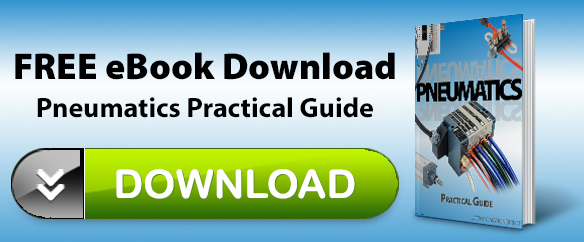Learn the ins and outs of PLCs with a variety of articles from AutomationDirect such as “What is a PLC?” to more complex topics involving ladder logic. There’s something from the beginner to the expert. Don’t forget to download our eBook to dive even deeper into the topic. Click to learn more.
ApplicationApplication StorieseBookEducation/DIYIndustryLearning ResourcesMachine ControlManufacturingOnline OnlyPneumatic eBookPneumaticsPneumaticsPneumatics eBookProduct
Pneumatic Application Stories
Want some examples of what people are doing with pneumatics? You’re in luck, we have a full collection of Application Stories here. For your convenience we took the time to list some of our favorites. You can see a preview below and then pick the ones that look the most interesting to you. Just remember that…
+Tech TopicseBookIssue 35 - 2016Learning ResourcesNotebook IssueOnline OnlyPneumatic eBookPneumaticsPneumatics eBookProduct
Pneumatic Actuator vs. Electromechanical
In materials handling and assembly there are many ways to move an item from one location to another. Conveyors are one way and are widely used, but they can only move objects in a fixed path, limiting their use in more precise manufacturing applications. When more accuracy is required than a conveyor can deliver, such…
+Tech TopicsAutomation NotebookeBookIssue 34 - 2016Learning ResourcesNotebook IssuePneumatic eBookPneumatics eBook
Why Use Pneumatics?
In manufacturing facilities, compressed air is so widely used that it is often regarded as the fourth utility after electricity, natural gas and water. But compared to electricity, compressed air is more expensive, so why is it so widely used to drive factory automation systems?
Reducing energy consumption is a priority in almost every manufacturing plant and industrial facility, as no company can afford to throw money away using machines and processes that waste energy. Because pneumatic systems are abundant throughout manufacturing and account for a large share of a plant’s power costs, it is extremely important that they run…
+Tech TopicsCover StorieseBookIssue 35 - 2016Learning ResourcesNotebook IssueOnline OnlyPneumatic eBookPneumaticsPneumatics eBookProduct
Are Pneumatic Components Compatible?
The industrial pneumatics market is fairly mature. While there continues to be new developments and technologies, many of the tried and true core products have been around for years. One advantage that this can offer to both system designers and end users is often having several brands of pneumatic components that are interchangeable with each…
+Tech TopicseBookLearning ResourcesOnline OnlyPneumatic eBookPneumaticsPneumatics eBookPneumatics MoreProduct
Pneumatic System Design Considerations
Pneumatic systems as a whole can be simple, but this simplicity can be deceptive when it comes to selecting components. For instance, there are thousands of types, sizes, and variations of cylinders and valves, from off-the-shelf versions to custom designs. The sheer number of choices can be overwhelming, especially when options such as sensors are…
A steady supply of clean and dry air is required to protect all the pneumatic components in machines, equipment and processes and to ensure their proper operation. While controlling mechanical motion with pneumatics—such as clamping, positioning, pushing and lifting—is often the focus, clean and dry air with enough flow to provide the required pressure must…
There are thousands of industrial applications that require a linear motion during their operation sequence. One of the simplest and most cost effective ways to accomplish this is with a pneumatic actuator. Pneumatic actuators are also very clean operating because the operating fluid is a gas, which prevents leakage from dripping and contaminating the surroundings.
+Tech TopicsAutomation NotebookIssue 35 - 2016Learning ResourcesNotebook IssueOnline OnlyPneumatic eBookPneumaticsPneumatics eBookProductTechnology Brief
Pneumatic Circuit Symbols Explained
Directional air control valves are the building blocks of pneumatic control. Pneumatic circuit symbols representing these valves provide detailed information about the valve they represent. Symbols show the methods of actuation, the number of positions, the flow paths and the number of ports. Here is a brief breakdown of how to read a symbol.
In order to perform a task using pneumatics, there needs to be some way to initiate, monitor, and stop the process. This is where a simple pneumatic system becomes electro-pneumatic. Electro-pneumatic systems integrate pneumatic and electrical technologies into one system where the signal/control medium is electrical and the working medium is compressed air. In this…
In today’s modern pneumatic systems, there are a variety of choices available to get the air preparation systems, valves and cylinders connected. Most designers use flexible pneumatic tubing or hose rather than rigid tubing, and many different types of both are available. Fittings offer many choices as well to meet the needs of a wide…
In the pneumatic world, valves are the equivalent of relays controlling the flow of electricity in automation systems. Instead of distributing electric power to motors, drives and other devices, pneumatic valves distribute air to cylinders, actuators and nozzles. Valve Activation Pneumatic valves, also called directional control valves, are activated in a variety of ways including…


